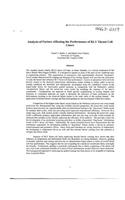
Analysis of Factors Affecting the Performance of Rlv Thrust Cell Liners
Series:
The reusable launch vehicle (RLV) thrust cell liner, or thrust chamber, is a critical component of the Space Shuttle Main Engine (SSME). It is designed to operate in some of the most severe conditions seen in engineering practice. This requirement, in conjunction with experimentally observed 'dog-house' failure modes characterized by bulging and thinning of the cooling channel wall, provides the m
NaN
VOLUME
English
Paperback

The reusable launch vehicle (RLV) thrust cell liner, or thrust chamber, is a critical component of the Space Shuttle Main Engine (SSME). It is designed to operate in some of the most severe conditions seen in engineering practice. This requirement, in conjunction with experimentally observed 'dog-house' failure modes characterized by bulging and thinning of the cooling channel wall, provides the motivation to study the factors that influence RLV thrust cell liner performance. Factors or parameters believed to be directly related to the observed characteristic deformation modes leading to failure under in-service loading conditions are identified, and subsequently investigated using the cylindrical version of the higher-order theory for functionally graded materials in conjunction with the Robinson's unified viscoplasticity theory and the power-law creep model for modeling the response of the liner s constituents. Configurations are analyzed in which specific modifications in cooling channel wall thickness or constituent materials are made to determine the influence of these parameters on the deformations resulting in the observed failure modes in the outer walls of the cooling channel. The application of thermal barrier coatings and functional grading are also investigated within this context. Comparison of the higher-order theory results based on the Robinson and power-law creep model predictions has demonstrated that, using the available material parameters, the power-law creep model predicts more precisely the experimentally observed deformation leading to the 'dog-house' failure mode for multiple short cycles, while also providing much improved computational efficiency. However, for a single long cycle, both models predict virtually identical deformations. Increasing the power-law creep model coefficients produces appreciable deformations after just one long cycle that would normally be obtained after multiple cycles, thereby enhancing the efficiency of the anal...
Price Comparison [India]
In This Series
Bestseller Manga
Trending NEWS




















